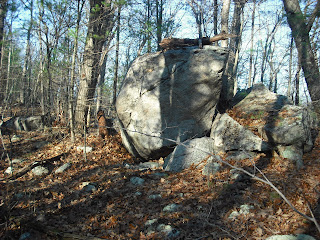The first propped boulder is this one, about 10 feet long, and propped three feet off the ground.
Further along and across the hill is a third massive propped boulder. There is a small bent tree in the foreground, and nothing under the boulder but some large rocks that look like manitous from this angle.
Finally, on top of the hill is a massive perched boulder with a striking wedge shape.
On the other side of this boulder is this pedestal boulder completely supported by stone feet. The afternoon sunlight streams under it.
This is the same one Larry Harrop found a few years ago. These places aren't as unknown as you would like to think; someone has left a can of SlimFast on top of the pedestal boulder. There's a bent tree marking this site.
Oddly enough, I find the most interesting feature of this site to be not the pedestal boulder, but the large, wedge-shaped perched boulder.
Four years ago I did this pen and ink drawing of it. Large wedge-like boulders seem to be a common feature in hilltop sites.
Here is a diagram of this hill, which is surrounded by wetlands. The boulders are drawn larger than scale for clarity.
The first three propped boulders are on a nearly straight line 365 feet long. The pedestal boulder site is 357 feet from the third propped boulder. It is quite a coincidence that on a hill covered with boulders, three large boulders in a nearly straight line are propped. It is also interesting that the third propped boulder is nearly the same distance from the pedestal boulder and the first boulder. This suggests that there was some design as to which boulders were propped.
These mysterious boulders may make great art subjects, but it is hard to explain their purpose. Maybe the space under the propped boulder was a portal to the spirit world, which would explain donation piles as offerings or mementos. Or maybe tribal shamans obtained medicine from these boulders. Or maybe they were shelters for natives on vision quests. The number of propped boulders in New England and beyond suggests some important function in native spirituality.










This comment has been removed by the author.
ReplyDeleteThis comment has been removed by the author.
ReplyDeleteNew comment - only deleted my invites to a walk that has already happened.
ReplyDeleteFirst photo - the formed points of these rocks point to some event or distant location. In particular, the boulder on the foreground has several lines. There is also a pair of parallel lines that line up with the 'point' of the boulder. My guess is that these siting lines give advance warning of the upcoming event in a short number of days. I have noticed this for equinox solar stones, but there is no reason why it might not be some other important time which occurs twice each year. Many stones appear to have marked more than one event and/or distant location, so this is only one perspective. Other photos also reveal these types of 'points'.
Beautiful photos, paintings and diagrams - very interesting work!